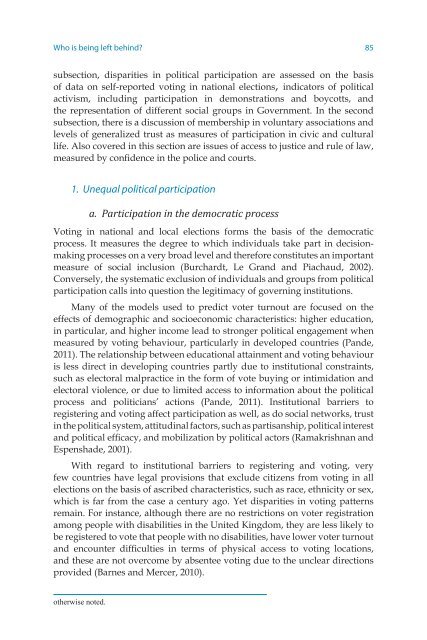Leaving no one behind the imperative of inclusive development
full-report
full-report
Create successful ePaper yourself
Turn your PDF publications into a flip-book with our unique Google optimized e-Paper software.
Who is being left <strong>behind</strong>? 85<br />
subsection, disparities in political participation are assessed on <strong>the</strong> basis<br />
<strong>of</strong> data on self-reported voting in national elections, indicators <strong>of</strong> political<br />
activism, including participation in demonstrations and boycotts, and<br />
<strong>the</strong> representation <strong>of</strong> different social groups in Government. In <strong>the</strong> second<br />
subsection, <strong>the</strong>re is a discussion <strong>of</strong> membership in voluntary associations and<br />
levels <strong>of</strong> generalized trust as measures <strong>of</strong> participation in civic and cultural<br />
life. Also covered in this section are issues <strong>of</strong> access to justice and rule <strong>of</strong> law,<br />
measured by confidence in <strong>the</strong> police and courts.<br />
1. Unequal political participation<br />
a. Participation in <strong>the</strong> democratic process<br />
Voting in national and local elections forms <strong>the</strong> basis <strong>of</strong> <strong>the</strong> democratic<br />
process. It measures <strong>the</strong> degree to which individuals take part in decisionmaking<br />
processes on a very broad level and <strong>the</strong>refore constitutes an important<br />
measure <strong>of</strong> social inclusion (Burchardt, Le Grand and Piachaud, 2002).<br />
Conversely, <strong>the</strong> systematic exclusion <strong>of</strong> individuals and groups from political<br />
participation calls into question <strong>the</strong> legitimacy <strong>of</strong> governing institutions.<br />
Many <strong>of</strong> <strong>the</strong> models used to predict voter tur<strong>no</strong>ut are focused on <strong>the</strong><br />
effects <strong>of</strong> demographic and socioeco<strong>no</strong>mic characteristics: higher education,<br />
in particular, and higher income lead to stronger political engagement when<br />
measured by voting behaviour, particularly in developed countries (Pande,<br />
2011). The relationship between educational attainment and voting behaviour<br />
is less direct in developing countries partly due to institutional constraints,<br />
such as electoral malpractice in <strong>the</strong> form <strong>of</strong> vote buying or intimidation and<br />
electoral violence, or due to limited access to information about <strong>the</strong> political<br />
process and politicians’ actions (Pande, 2011). Institutional barriers to<br />
registering and voting affect participation as well, as do social networks, trust<br />
in <strong>the</strong> political system, attitudinal factors, such as partisanship, political interest<br />
and political efficacy, and mobilization by political actors (Ramakrishnan and<br />
Espenshade, 2001).<br />
With regard to institutional barriers to registering and voting, very<br />
few countries have legal provisions that exclude citizens from voting in all<br />
elections on <strong>the</strong> basis <strong>of</strong> ascribed characteristics, such as race, ethnicity or sex,<br />
which is far from <strong>the</strong> case a century ago. Yet disparities in voting patterns<br />
remain. For instance, although <strong>the</strong>re are <strong>no</strong> restrictions on voter registration<br />
among people with disabilities in <strong>the</strong> United Kingdom, <strong>the</strong>y are less likely to<br />
be registered to vote that people with <strong>no</strong> disabilities, have lower voter tur<strong>no</strong>ut<br />
and encounter difficulties in terms <strong>of</strong> physical access to voting locations,<br />
and <strong>the</strong>se are <strong>no</strong>t overcome by absentee voting due to <strong>the</strong> unclear directions<br />
provided (Barnes and Mercer, 2010).<br />
o<strong>the</strong>rwise <strong>no</strong>ted.
















